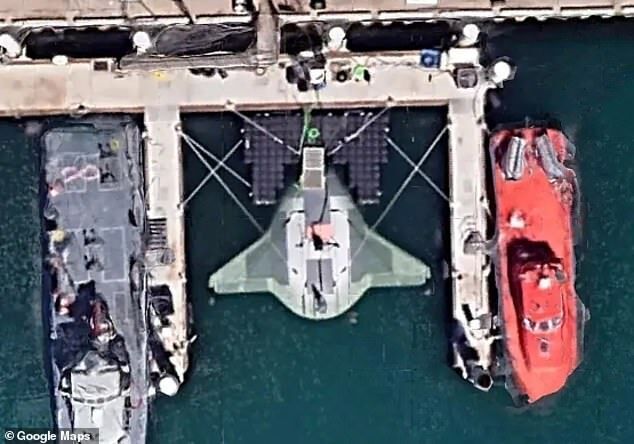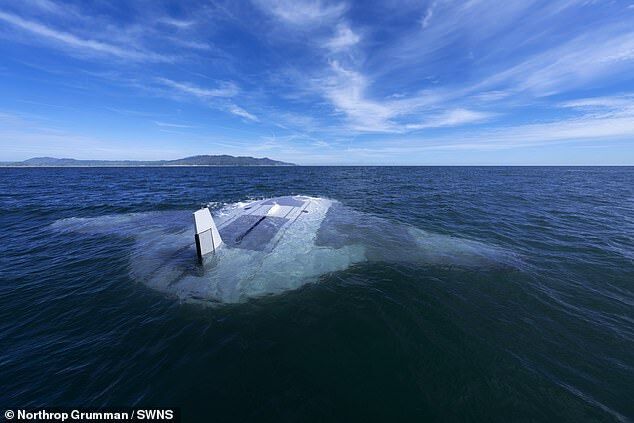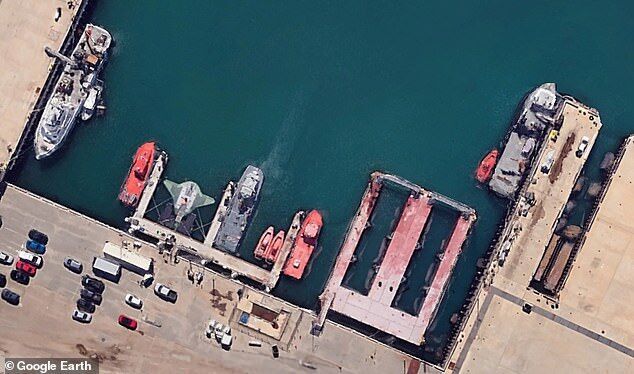
Satellite images showing the vessel docked at Port Hueneme naval base in California went viral on Sunday, before some social media users said the satellite images were removed, and replaced with what people believed were edited boats.
As it stands, however, satellite images of the vessel can be seen on Google Earth.
The vessel - named after the sea creature due to its diamond-shaped body and wing-like fins - is used for underwater threat detection and was designed by Northrop Grumman Corporation.
The aerospace group's futuristic underwater drone is part of a US navy project to develop a new class of underwater drones which are capable of carrying out much longer missions.
The unmanned, underwater craft, has been designed to move through the ocean without human supervision or the need to refuel, and it is also able to hibernate on the seabed in a 'low power mode'.
The ultimate goal is allowing soldiers to continue their mission on land without being interrupted to power, maintain and refuel an underwater machine.
Northrop Grumman also says that due to its modular design, it can be dismantled and transported in standard shipping containers for rapid deployment.
The military machine is the first in a new class of long duration, long range and payload-capable unmanned undersea vehicles, which carry out missions without the need of human interference.
Until recently, its pioneering design, which allows it to stay submerged for long periods of time, had been kept secret.
Comment: It remains to be seen whether in a real world scenario it lives up to these claims: US F-35B test jet crashes shortly after takeoff in New Mexico

Just last week, Northrop Grumman revealed more details on its robotic 'Manta Ray' submersible in some newly-released videos.
Comment: This capture on Google Earth may be interesting timing, although it could simply be that the two events coincide because Manta Ray is docked and they just 'forgot' to censor Google - considering the incompetence plaguing the US, it's hard to tell.
In these, footage shows a tour of the first test dive and a rundown on the project never-before-seen clips.
Northrop Grumman announced that it had completed full-scale, in-water testing off the coast of Southern California in February and March this year.
With the underwater vehicle undergoing recent testing, questions have been raised over the emergence of advanced sea drones in reshaping naval combat, as Ukrainian forces have been using smaller, more affordable technology to sink Russian ships.
Comment: In a number of instances it seems more likely that the West just undertook these attacks themselves.
Some defense analysts have speculated that the US navy ants to develop a drone capable of carrying out long missions to search the seas for Russian and Chinese submarines, according to The Telegraph.
This comes after it was first announced four years ago that a new class of 'extra-large Manta Ray' underwater drones would be built by Lockheed Martin after the Pentagon awarded the firm $12.3 million.
The leader in global security and aerospace had been awarded the contract to start the first phase of the Manta Ray program from the Defense Advanced Research Projects Agency (DARPA) - the U.S. Department of Defense's experimental research arm.
By harnessing marine organisms' ability to sense even the most minute disturbances in their environments, DARPA said it could be able to preemptively discover even the smallest autonomous vehicles.




Reader Comments
Just begging for "ooops" seems like.
A psyop, in other words.
[Link]
"Airside" you can find a upward gliding airship in the video section of www.hyperblimp.com. I've not updated this site since 2012, but you get the idea.
P.S. Anyone knowing a serious pool toy manufacturer or interested party with modestly deep pockets can find me at the bottom of the airship page.